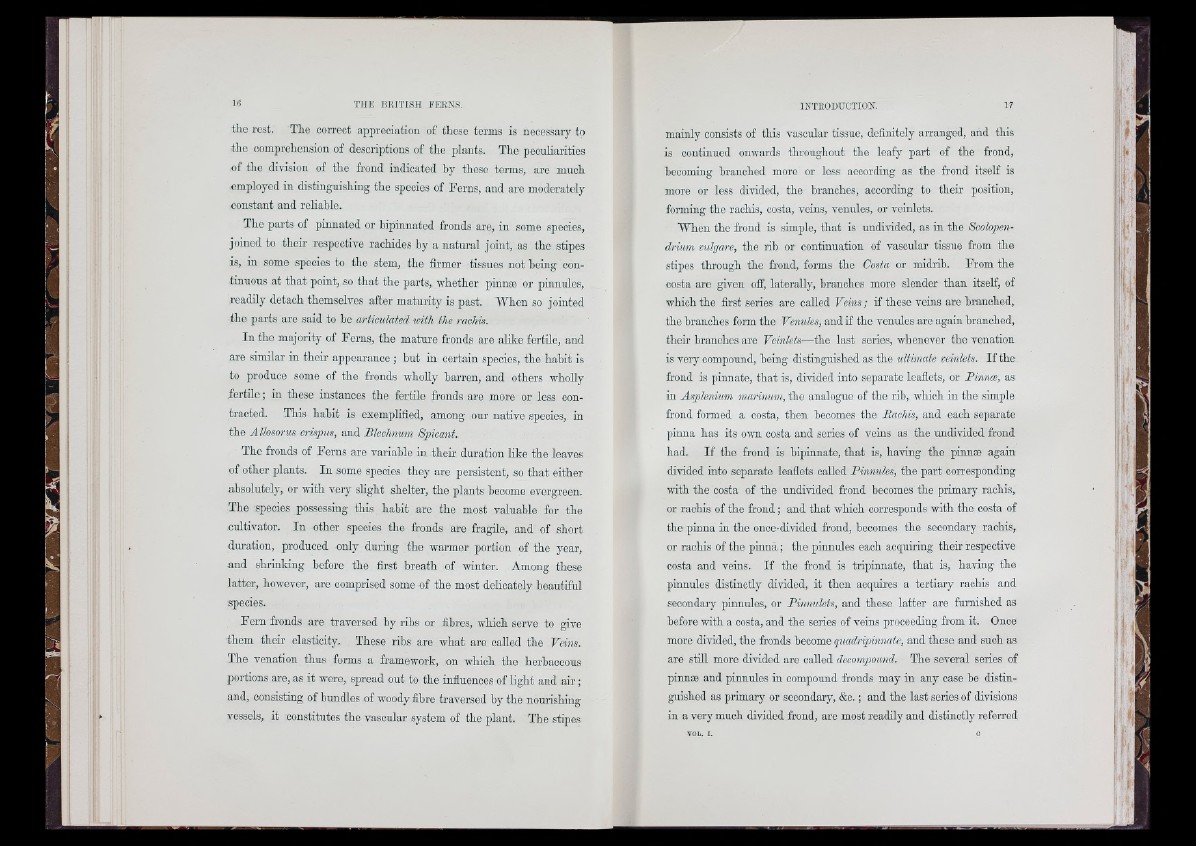
the rest. The correct appreciation of these terms is necessary to
the comprehension of descriptions of the plants. The peculiarities
of the division of the frond indicated hy these terms, are much
cmploj^ed in distinguishing the species of Ferns, and are moderately
constant and reliable.
The parts of pinnated or hipinnatod fronds are, in some species,
joined to their respective rachides by a natural joint, as tho stipes
is, in some species to the stem, the firmer tissues not being continuous
at that point, so that tho parts, whether pinnæ or pinnules,
readily detach themselves after maturity is past. When so jointed
the parts are said to bo articulated with the rachis.
In the majority of Ferns, the mature fronds are alike fertile, and
arc similar in their appearance ; but in certain species, the habit is
to produce some of the fronds wholly barren, and others wholly
fertile ; in these instances the fertile fronds are more or less contracted.
This habit is exemplified, among our native species, in
the Allosorus crispus, and Bhchnum Spicant.
The fronds of Ferns are variable in their duration like the leaves
of other plants. In some species they are persistent, so th a t either
absolutely, or with very slight shelter, the plants become evergreen.
The species possessing this habit are the most valuable for the
cultivator. In other species the fronds are fragile, and of short
duration, produced only during the warmer portion of tho year,
and shrinking before the first breath of winter. Among these
latter, however, are comprised some of the most delicately beautiful
species.
Fern fronds are traversed by ribs or fibres, which serve to give
them their elasticity. These ribs are what are called the Veins.
The venation thus forms a framework, on which the herbaceous
portions are, as it were, spread out to the influences of light and air ;
and, consisting of bundles of woody fibre traversed by the nourishing
vessels, it constitutes the vascular system of the plant. The stipes
mainly consists of this vascular tissue, definitely arranged, and this
is continued onwards throughout the leafy part of the frond,
becoming branched more or less according as the frond itself is
moro or less divided, the branches, according to their position,
forming the rachis, costa, veins, venules, or veinlets.
When the frond is simple, that is undivided, as in the Scolopen-
drium mlgare, tho rib or continuation of vascular tissue from the
stipes through tho frond, forms the Costa or midrib. From the
costa aro given off, laterally, branches more slender than itself, of
which the first series are called Veins ; if these veins are branched,
the branches form the Venules, and if the venules are again branched,
their branches aro Veinlets—the last series, whenever the venation
is very compound, being distinguished as the ultimate veinlets. I f the
frond is pinnate, that is, divided into separate leaflets, or Finnæ, as
in Asplénium marinum, the analogue of the rib, which iu the simple
frond formod a costa, then becomes tho Rachis, and each separate
pinna has its own costa and scries of veins as tho undivided frond
had. I f tho frond is bipinnate, that is, having the pinnæ again
divided into separate leaflets called Pinnules, the part corresponding
with the costa of the undivided frond becomes the primary rachis,
or rachis of the frond ; and that which corresponds with the costa of
the pinna in the once-divided frond, becomes the secondary rachis,
or raohis of the pinna ; the pinnules each acquiring their respective
costa and veins. I f the frond is tripinnate, that is, having the
pinnules distinctly divided, it then acquires a tertiary rachis and
secondary pinnules, or Fimiulets, and these latter are furnished as
before witb a costa, and the series of veins proceeding from it. Once
more divided, the fronds become quadripinnate, and these and such as
are still more divided are called decompound. The several series of
pinnæ and pinnules in compound fronds may in any case be distinguished
as primary or secondary, &o. ; and the last series of divisions
in a very much divided frond, are most readily and distinctly referred